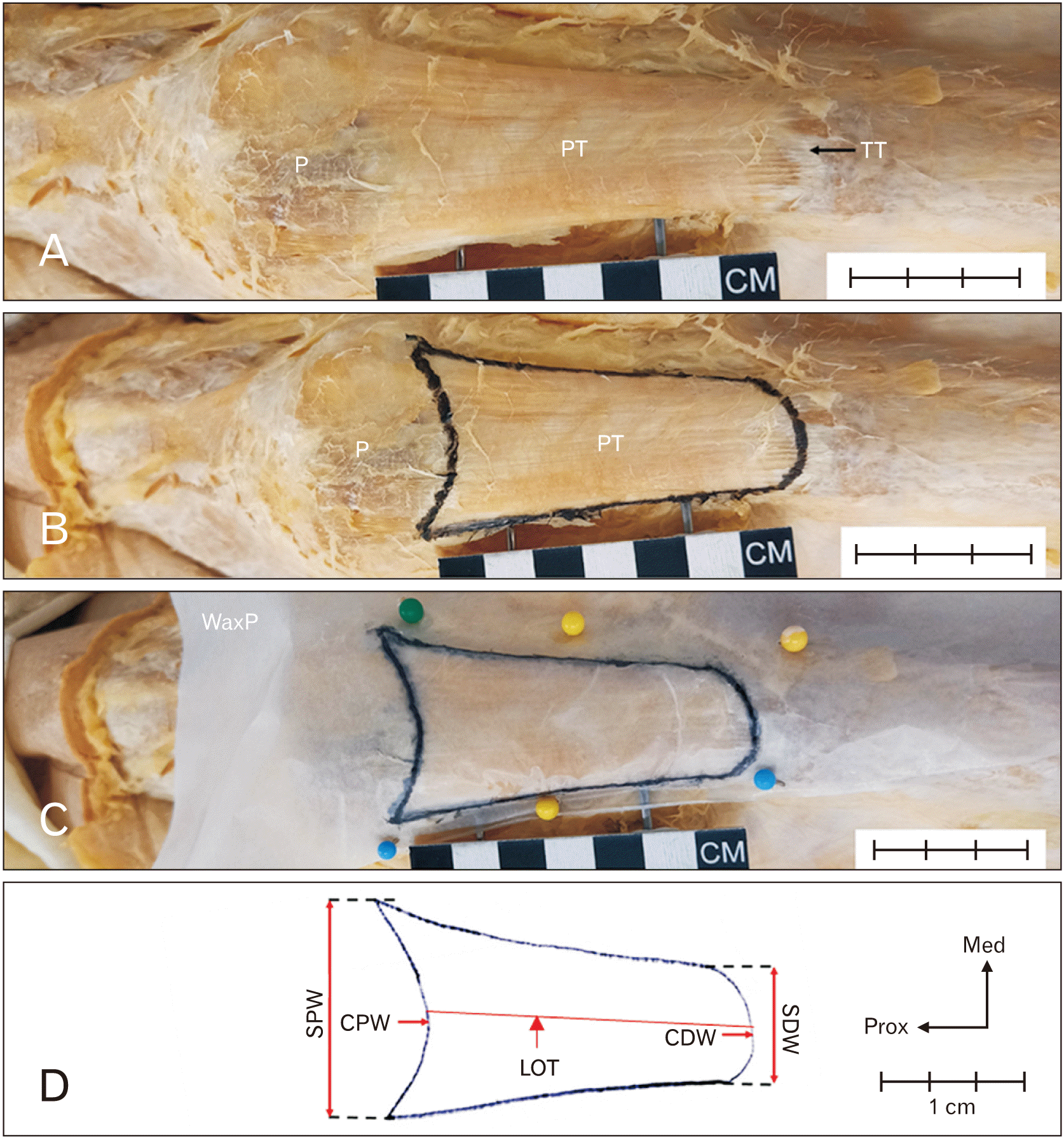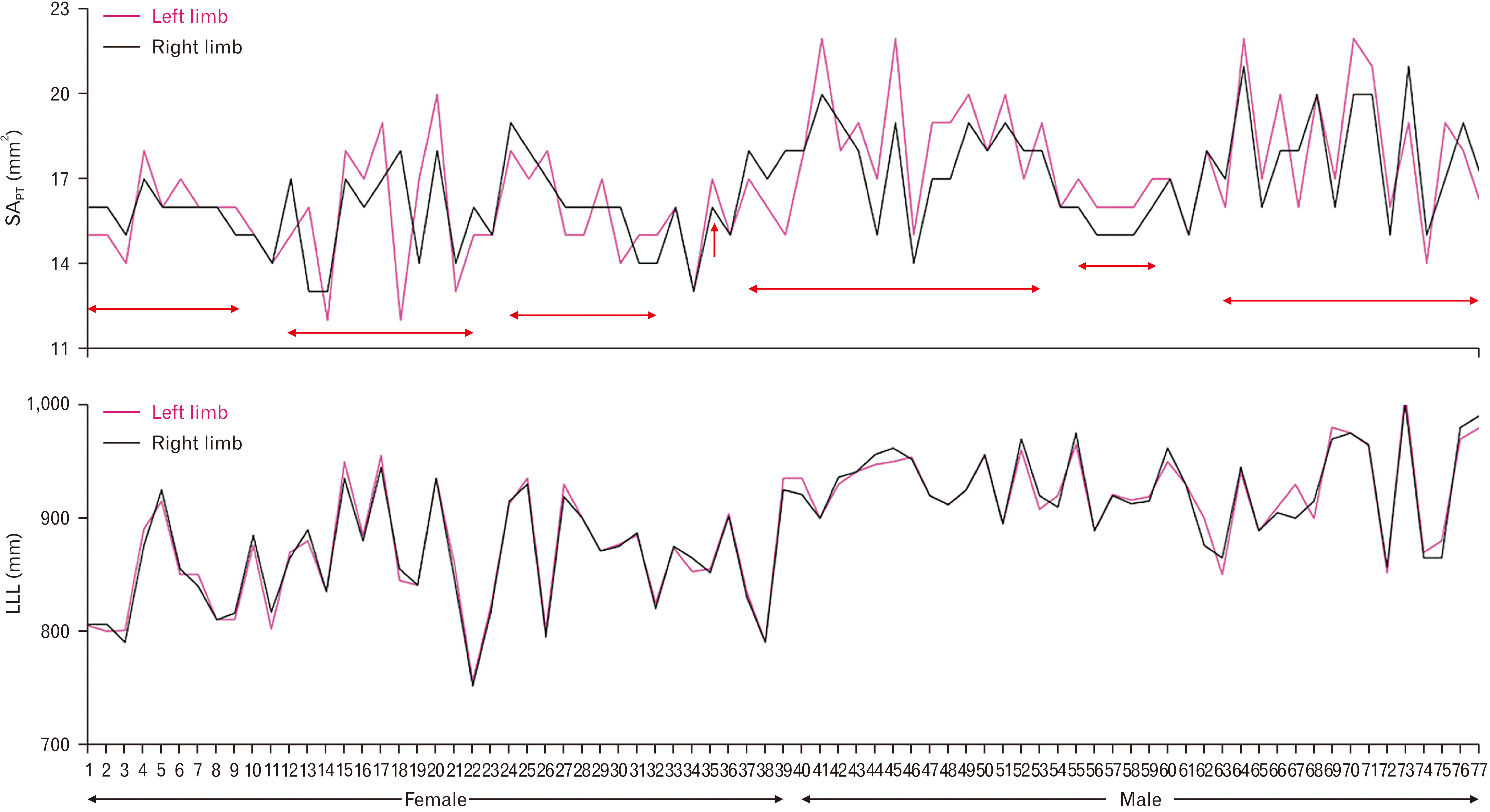1. Zhu J, Zhang X, Ma Y, Zhou C, Ao Y. 2012; Ultrastructural and morphological characteristics of human anterior cruciate ligament and hamstring tendons. Anat Rec (Hoboken). 295:1430–6. DOI:
10.1002/ar.22527. PMID:
22807249.

2. Cerulli G, Placella G, Sebastiani E, Tei MM, Speziali A, Manfreda F. 2013; ACL reconstruction: choosing the graft. Joints. 1:18–24. PMID:
25606507. PMCID:
PMC4295687.
3. Markatos K, Kaseta MK, Lallos SN, Korres DS, Efstathopoulos N. 2013; The anatomy of the ACL and its importance in ACL reconstruction. Eur J Orthop Surg Traumatol. 23:747–52. DOI:
10.1007/s00590-012-1079-8. PMID:
23412211.

4. Quatman CE, Hewett TE. 2009; The anterior cruciate ligament injury controversy: is "valgus collapse" a sex-specific mechanism? Br J Sports Med. 43:328–35. Erratum in: Br J Sports Med 2021;55:e6. DOI:
10.1136/bjsm.2009.059139. PMID:
19372087. PMCID:
PMC4003572.

6. Hurley ET, Calvo-Gurry M, Withers D, Farrington SK, Moran R, Moran CJ. 2018; Quadriceps tendon autograft in anterior cruciate ligament reconstruction: a systematic review. Arthroscopy. 34:1690–8. DOI:
10.1016/j.arthro.2018.01.046. PMID:
29628380.

7. Hamada M, Shino K, Mitsuoka T, Abe N, Horibe S. 1998; Cross-sectional area measurement of the semitendinosus tendon for anterior cruciate ligament reconstruction. Arthroscopy. 14:696–701. DOI:
10.1016/S0749-8063(98)70096-9. PMID:
9788365.

9. Reboonlap N, Nakornchai C, Charakorn K. 2012; Correlation between the length of gracilis and semitendinosus tendon and physical parameters in Thai males. J Med Assoc Thai. 95(Suppl 10):S142–6.
10. Janssen RP, Scheffler SU. 2014; Intra-articular remodelling of hamstring tendon grafts after anterior cruciate ligament reconstruction. Knee Surg Sports Traumatol Arthrosc. 22:2102–8. DOI:
10.1007/s00167-013-2634-5. PMID:
23982759. PMCID:
PMC4142140.

12. Mall NA, Matava MJ, Wright RW, Brophy RH. 2012; Relation between anterior cruciate ligament graft obliquity and knee laxity in elite athletes at the National Football League combine. Arthroscopy. 28:1104–13. DOI:
10.1016/j.arthro.2011.12.018. PMID:
22421564.

14. Xerogeanes JW, Mitchell PM, Karasev PA, Kolesov IA, Romine SE. 2013; Anatomic and morphological evaluation of the quadriceps tendon using 3-dimensional magnetic resonance imaging reconstruction: applications for anterior cruciate ligament autograft choice and procurement. Am J Sports Med. 41:2392–9. DOI:
10.1177/0363546513496626. PMID:
23893419.

15. Van Zyl R, Van Schoor AN, Du Toit PJ, Louw EM. 2016; Clinical anatomy of the anterior cruciate ligament and pre-operative prediction of ligament length. SA Orthop J. 15:47–52. DOI:
10.17159/2309-8309/2016/v15n4a7.

16. Gupta R, Malhotra A, Masih GD, Khanna T. 2017; Equation-based precise prediction of length of hamstring tendons and quadrupled graft diameter by various anthropometric variables for knee ligament reconstruction in Indian population. J Orthop Surg (Hong Kong). 25:2309499017690997. DOI:
10.1177/2309499017690997. PMID:
28228049. PMID:
62a74879e4ce4daab083ca17fd770ac0.

17. Vadgaonkar R, Prameela MD, Murlimanju BV, Tonse M, Kumar CG, Massand A, Blossom V, Prabhu LV. 2018; Morphometric study of the semitendinosus muscle and its neurovascular pedicles in South Indian cadavers. Anat Cell Biol. 51:1–6. DOI:
10.5115/acb.2018.51.1.1. PMID:
29644103. PMCID:
PMC5890011.

18. Hadjicostas PT, Soucacos PN, Berger I, Koleganova N, Paessler HH. 2007; Comparative analysis of the morphologic structure of quadriceps and patellar tendon: a descriptive laboratory study. Arthroscopy. 23:744–50. DOI:
10.1016/j.arthro.2007.01.032. PMID:
17637410.

19. Shani RH, Umpierez E, Nasert M, Hiza EA, Xerogeanes J. 2016; Biomechanical comparison of quadriceps and patellar tendon grafts in anterior cruciate ligament reconstruction. Arthroscopy. 32:71–5. DOI:
10.1016/j.arthro.2015.06.051. PMID:
26382635.

21. Hijazi MM, Khan MA, Altaf FMN, Ahmed MR, Alkhushi AG, Sakran AMEA. 2015; Quadriceps tendon and patellar ligament; a morphometric study. Prof Med J. 22:1192–5. DOI:
10.29309/TPMJ/2015.22.09.1135.

22. DeFroda S, Fice M, Tepper S, Bach BR Jr. 2021; Our preferred technique for bone-patellar tendon-bone allograft preparation. Arthrosc Tech. 10:e2591–6. DOI:
10.1016/j.eats.2021.08.002. PMID:
34868866. PMCID:
PMC8626798.

24. Slone HS, Romine SE, Premkumar A, Xerogeanes JW. 2015; Quadriceps tendon autograft for anterior cruciate ligament reconstruction: a comprehensive review of current literature and systematic review of clinical results. Arthroscopy. 31:541–54. DOI:
10.1016/j.arthro.2014.11.010. PMID:
25543249.

25. Drake RL. Drake RL, Wayne Vogl A, Mitchell AWM, editors. 2010. Lower limb. Gray's Anatomy for Students. 2nd ed. Churchill Livingstone;Philadelphia: p. 558–64. DOI:
10.1016/B978-0-443-06952-9.00011-4.

27. Goldblatt JP, Fitzsimmons SE, Balk E, Richmond JC. 2005; Reconstruction of the anterior cruciate ligament: meta-analysis of patellar tendon versus hamstring tendon autograft. Arthroscopy. 21:791–803. DOI:
10.1016/j.arthro.2005.04.107. PMID:
16012491.

28. Latiff S, Olateju OI. 2022; Morphometry of the harvestable surface area of quadriceps tendon using a simple tracing method: a common ACL autograft. Eur J Anat. 26:679–90. DOI:
10.52083/TDBN2622.

29. Latiff S, Olateju OI. 2022; Quantification and comparison of tenocyte distribution and collagen content in the commonly used autografts for anterior cruciate ligament reconstruction. Anat Cell Biol. 55:304–10. DOI:
10.5115/acb.22.005. PMID:
35668478. PMCID:
PMC9519766.

31. Landis JR, Koch GG. 1977; The measurement of observer agreement for categorical data. Biometrics. 33:159–74. DOI:
10.2307/2529310. PMID:
843571.

32. Schober P, Boer C, Schwarte LA. 2018; Correlation coefficients: appropriate use and interpretation. Anesth Analg. 126:1763–8. DOI:
10.1213/ANE.0000000000002864. PMID:
29481436.
33. Milankov M, Obradović M, Vranješ M, Budinski Z. 2015; Bone-patellar tendon-bone graft preparation technique to increase cross-sectional area of the graft in anterior cruciate ligament reconstruction. Med Pregl. 68:371–5. DOI:
10.2298/MPNS1512371M. PMID:
26939302.

34. Aithal Padur A, Kumar N, Lewis MG, Sekaran VC. 2021; Morphometric analysis of patella and patellar ligament: a cadaveric study to aid patellar tendon grafts. Surg Radiol Anat. 43:2039–46. DOI:
10.1007/s00276-021-02837-z. PMID:
34570285. PMCID:
PMC8536615.

35. Toritsuka Y, Horibe S, Mitsuoka T, Nakamura N, Hamada M, Shino K. 2003; Comparison between the cross-sectional area of bone-patellar tendon-bone grafts and multistranded hamstring tendon grafts obtained from the same patients. Knee Surg Sports Traumatol Arthrosc. 11:81–4. DOI:
10.1007/s00167-003-0349-8. PMID:
12664199.

36. Abuhaimed AK, Almulhim AM, Alarfaj FA, Almustafa SS, Alkhater KM, Al Yousef MJ, Al Bayat MI, Madadin M, Menezes RG. 2020; Histologic reliability of tissues from embalmed cadavers: can they be useful in medical education? Saudi J Med Med Sci. 8:208–12. DOI:
10.4103/sjmms.sjmms_383_19. PMID:
32952513. PMCID:
PMC7485655.

37. Stäubli HU, Schatzmann L, Brunner P, Rincón L, Nolte LP. 1996; Quadriceps tendon and patellar ligament: cryosectional anatomy and structural properties in young adults. Knee Surg Sports Traumatol Arthrosc. 4:100–10. DOI:
10.1007/BF01477262. PMID:
8884731.

39. Frank RM, Higgins J, Bernardoni E, Cvetanovich G, Bush-Joseph CA, Verma NN, Bach BR Jr. 2017; Anterior cruciate ligament reconstruction basics: bone-patellar tendon-bone autograft harvest. Arthrosc Tech. 6:e1189–94. DOI:
10.1016/j.eats.2017.04.006. PMID:
29354416. PMCID:
PMC5621981.

40. Mehran N, Skendzel JG, Lesniak BP, Bedi A. 2013; Contemporary graft options in anterior cruciate ligament reconstruction. Oper Tech Sports Med. 21:10–8. DOI:
10.1053/j.otsm.2012.10.005.

41. Shelbourne KD, Urch SE. 2000; Primary anterior cruciate ligament reconstruction using the contralateral autogenous patellar tendon. Am J Sports Med. 28:651–8. DOI:
10.1177/03635465000280050501. PMID:
11032219.
42. de Souza Borges JH, Oliveira M, Junior PL, de Souza Machado R, Lima R, Ramos LA, Cohen M. 2022; Is contralateral autogenous patellar tendon graft a better choice than ipsilateral for anterior cruciate ligament reconstruction in young sportsmen? A randomized controlled trial. Knee. 36:33–43. DOI:
10.1016/j.knee.2022.03.015. PMID:
35468330.

43. Slone HS, Ashford WB, Xerogeanes JW. 2016; Minimally invasive quadriceps tendon harvest and graft preparation for all-inside anterior cruciate ligament reconstruction. Arthrosc Tech. 5:e1049–56. DOI:
10.1016/j.eats.2016.05.012. PMID:
27909674. PMCID:
PMC5124375.

44. Connaughton AJ, Geeslin AG, Uggen CW. 2017; All-inside ACL reconstruction: how does it compare to standard ACL reconstruction techniques? J Orthop. 14:241–6. DOI:
10.1016/j.jor.2017.03.002. PMID:
28360487. PMCID:
PMC5360217.

45. Jones PE, Schuett DJ. 2018; All-inside anterior cruciate ligament reconstruction as a salvage for small or attenuated hamstring grafts. Arthrosc Tech. 7:e453–7. DOI:
10.1016/j.eats.2017.11.007. PMID:
29868418. PMCID:
PMC5984294.

47. Yoo JH, Yi SR, Kim JH. 2007; The geometry of patella and patellar tendon measured on knee MRI. Surg Radiol Anat. 29:623–8. DOI:
10.1007/s00276-007-0261-x. PMID:
17898923.

48. Oikawa R, Tajima G, Yan J, Maruyama M, Sugawara A, Oikawa S, Saigo T, Takahashi H, Doita M. 2019; Morphology of the patellar tendon and its insertion sites using three-dimensional computed tomography: a cadaveric study. Knee. 26:302–9. DOI:
10.1016/j.knee.2018.12.002. PMID:
30635153.

49. Hardy A, Casabianca L, Andrieu K, Baverel L, Noailles T. 2017; Complications following harvesting of patellar tendon or hamstring tendon grafts for anterior cruciate ligament reconstruction: systematic review of literature. Orthop Traumatol Surg Res. 103(8S):S245–8. DOI:
10.1016/j.otsr.2017.09.002. PMID:
28888527.
50. Barié A, Sprinckstub T, Huber J, Jaber A. 2020; Quadriceps tendon vs. patellar tendon autograft for ACL reconstruction using a hardware-free press-fit fixation technique: comparable stability, function and return-to-sport level but less donor site morbidity in athletes after 10 years. Arch Orthop Trauma Surg. 140:1465–74. DOI:
10.1007/s00402-020-03508-1. PMID:
32504178. PMCID:
PMC7505888.

51. Latiff S, Bidmos MA, Olateju OI. 2021; Morphometric profile of tendocalcaneus of South Africans of European ancestry using a cadaveric approach. Folia Morphol (Warsz). 80:196–203. DOI:
10.5603/FM.a2020.0026. PMID:
32159844.







 PDF
PDF Citation
Citation Print
Print



 XML Download
XML Download